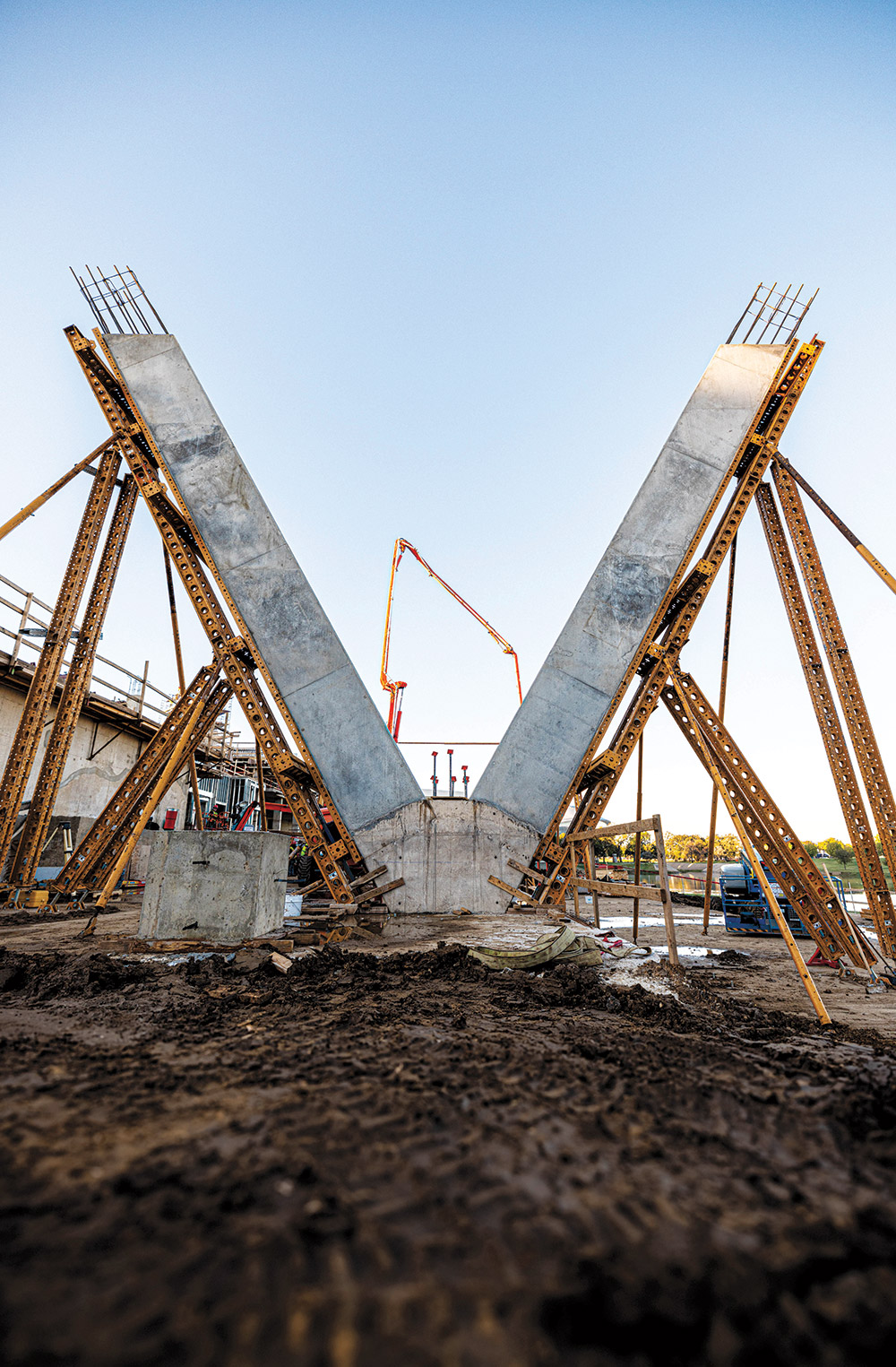ENR 2024 Top 600 Specialty Firms: Contractor Collaboration Shines
October 24, 2024
ENR 2024 Top 600 Specialty Firms: Contractor Collaboration Shines
October 24, 2024
Related Links:
ENR 2024 Top 600 Rankings
View Complete List with Revenue and Market Data
(Requires Subscription)
Business is still booming for ENR’s Top 600 Specialty Contractors following a third consecutive year of double-digit revenue growth despite strained labor pools, rising construction costs and shifting sector demands. Firms revealed in comments that their greatest measure of success is the ability to invest in their employees.
As much as construction technology has improved workplace efficiency, speed of information and reporting in a short period of time for many Top 600 firms, construction is still a “nuts and bolts” business “where we are constructing a building one piece and one screw at a time,” says Michael Dominici, executive vice president of the Circle Group.
In effect, many specialty contractors find that adopting new technology is still a people-centered process. “Many are resistant to change, which is understandable, but ultimately it helps improve efficiency and save time once it is mastered,” says Dominici. “Supervisory field staff must learn to adapt to the new technologies being implemented.”
The No. 321-ranked specialty firm has focused on diversifying its portfolio to break into new markets, says Dominici, but finding skilled labor to scale up remains a challenge. “It costs money to attract top-tier talent and to maintain your key field staff,” he adds.


Harmon is working on the 48-story, 800,000-sq-ft the Republic office tower in Austin, Texas. Its facade will be a custom curtain wall that incorporates 9-in. vertical fin blades with panel bands and a structural glass wall.
Photo courtesy of Harmon Inc.
Reconfiguring Operations
To keep projects moving and to stay on top of opportunities for growth, firm executives say they are reconfiguring their resources to reinvest more in their internal operations.
“As we continue to grow as an organization, one of our top priorities and areas for improvement is successfully leveraging the opportunities within the markets that we currently serve,” says TDIndustries’ David Fultz, who is president of preconstruction and business improvement. “It is increasingly important to remain stable and strong and serve clients well as we continue to scale.”
He adds that the No. 49-ranked firm is “ceaselessly committed to being the employer of choice for skilled professionals in our industry and want [employees] to be connected to something more than just a job.”
With the world shifting post-COVID-19, how firms measure success has also shifted—with a greater emphasis on skill development, adds Ben Johnston, board chairman of Pittsburg Tank & Tower Group.
“In the construction industry, we need to keep projects moving at a pace that does not restrain the flow of progress,” he says. “Keeping approvals and documentation up with the pace of some of the projects has been a challenge. In keeping with our goals of last year, we continue to put resources into employee development.” This includes growth groups, lunch and learns, collaboration teams and lessons learned logs, Johnson explains.
Another goal for the No. 312-ranked specialty contractor has been to review newly proposed federal heat-related regulations to get them “rolled into our operational procedures in a quick, efficient manner,” says Johnston.
“Labor inflation has been the biggest challenge,” he adds. “New technology in equipment and software are tools to help offset the increases.”
Shifting Markets
Revenue for the Top 600 Specialty Contractors rose 15.1% to $214.5 billion in 2023 from $186.4 billion in 2022. Among the 544 firms that filed surveys for this year’s ranking and for last year’s, 73.3% reported an increase in revenue. The equivalent number for last year’s list was 79.4%.
Median firm revenue last year increased 10.9% to $118.3 million from $106.7 million. New contracts for this year’s Top 600 also rose 24.2%, and median firm new contract totals are up 13.6% to $114.7 million. Overall, 95.8% of reporting firms said they made a profit in 2023.
Yet beyond the numbers, revenue increases reflect a concerted effort by firms to streamline operations and proactively address market challenges.
have set a very aggressive profit growth strategy that includes expanding both our geographical and industrial market footprints,” says Karl H. Watson Jr., CEO of Baker Construction Enterprises, ranked at No. 15. “Maintaining a robust talent pipeline will be key to achieving this. If we are going to be firing on all cylinders, we need to ensure we have the right people with the right skills who share our values in the right places.”
Watson says the firm has always been intentional about who it hires, but now it is applying those resources and strategy to developing its current roster of employees.
“This is good for our company and good for our people, but it’s also an essential component to creating more value for our clients,” he says.
Over the last 18-20 months, Lithko Contracting says it faced a number of challenges connected to a change in its number of project starts. The firm is ranked No. 22.“Mixed-use and warehouse projects have decreased by as much as 60%, with rental rates dropping as interest rates have increased,” says CEO Rob Strobel. “This slowdown in available work combined with the impact of a shifting [project]mix, have been [some] of our biggest challenges.”

“This slowdown in available work combined with the impact of a shifting work mix has been one of our biggest challenges. ”
Rob Strobel, CEO, Lithko Contracting
But with federal funding fueling investments in infrastructure, data centers, microchip manufacturing and alternative energy projects, Strobel says the firm is positioning itself to grow its footprint in these developing sectors.
“Our primary goal for next year is to make strong moves in these emerging markets and establish ourselves as the premier concrete construction builder in the microchip and data center spaces,” he says.
Revenue is up for Top 600 firms across all construction markets that ENR tracks. The manufacturing sector continues to stand out, climbing 45.1% between 2022 and 2023—having risen 33% or more in each of the past three years. In 2019, manufacturing captured 6.1% of total Top 600 revenue. That figure is 11.3% for 2023. The transportation (up 25.6% from 2022-23), sewer/waste (24.3%) and power (23.8%) markets also saw significant increases.
“We seek out the best of those opportunities, from automotive or general manufacturing to the erection of airports, arenas and sports facilities or servicing the electric power industry,” says Bob Dunn, CEO of National Steel City. He adds that the No. 371-ranked firm is well prepared and positioned to adapt to market shifts for its services over time.
“Keeping abreast of these trends can be a challenge, but a challenge our team is prepared for, which requires our attention on an almost daily basis,” says Dunn.
For Skoda Contracting, CEO Dane Evans says the firm’s largest challenge has been budget constraints from its utility clients.
“The priority of these clients has been safety and quality, but this year we have seen a flight to lower cost service providers,” he says. “As an organization, we have recognized the need to compress margins and become leaner in order to maintain market share. We do not see this as a long-term problem but most likely a lagging effect of the interest rate environment experienced over the last three years.” Next year, the firm aims to expand its suite of services and grow its water and electric units “in order to complement our gas construction business,” says Evans. “We hope that this acts as a hedge to the cyclical budgets of our gas utility clients.”
Manufacturing | By Jonathan Keller
Managing Increasing Costs

Photo courtesy of Keller North America
Keller North America (No. 17) is providing ground improvement services over approximately 15 million sq ft of building pads on the $2-billion Scout Motors electric vehicle plant in Blythewood, S.C. The primary scope of work is the installation of aggregate piers with varying depths of 5-30 ft. The facility is scheduled to start production in 2026.
Managing Increasing Costs
Top 600 firms reported a slight improvement in their payment collection schedules. The proportion of payments past due decreased to 25.9% in 2023, from 28.3% in 2021 and 26.7% in 2022.
However, firms report a number of cost hikes eating into their profit margins. “Costs are continuing to increase in terms of labor, insurance and equipment,” says Ward Electric CEO Mark Ward. “From an equipment standpoint, we strive to manage those cost increases through the use of RPOs as well as long- and short-term leases.” He refers to rental purchase options that allow the firm to apply a portion of equipment rental payments toward purchases.
Robert J. Massey Jr., president and CEO of Massey’s Plate Glass & Aluminum, says the No. 293-ranked specialty contractor has also noticed an increase in the cost of material goods. “Unfortunately not all vendors hold their pricing,” says Massey, which results in material cost overruns that “sometimes the end user will not compensate for unless there was direct lack of timeliness on their part.”

“Keeping abreast of these trends can be a challenge, but a challenge our team is prepared for—which requires our attention on an almost daily basis. ”
Bob Dunn, CEO, National Steel City
Encore Electric President Andy Gordon says the firm’s cost increases have largely resulted from boosting its cybersecurity. “Absorbing the increased cybersecurity costs is critical to protecting our company, employees and customer information,” he says. “For Encore Electric, safeguarding our information is non-negotiable. One way we’re looking to avoid [information being compromised] is an increase in educating our workforce to better understand and identify these issues.”
Adding to Ward’s point, Hodess Cleanrooms CEO Blake Hodess notes that it is not only the cost of equipment that is a concern for many contractors but also the procurement lead time.“Our approach to project management typically relies on either a design-build or design-build-assist arrangement that ensures that our purchasing group is deeply involved in the pre-construction phase,” he says. “This integration helps ensure our client’s needs are understood across the team and allows our engineering group to make adjustments, as needed, based on feedback from purchasing.”
Lithko’s Strobel says cost increases “have now balanced out” for the firm, partly thanks to its strategy of defining those costs up front and setting contract agreements to ensure they will be carried through to completion. “This proactive approach helped us offset any potential price increases during the project,” he adds. “As one of the largest concrete contractors, we have been able to leverage our buying power with larger, more stable supply chain partners.”
He adds that by using “our size and relationships, we ensure we secure our materials first, especially when facing constraints. Currently, there is minimal bottlenecking in the supply chain.”
The Top 600 Dialogue
What changes have you made over the years to improve the effectiveness of your safety program?

Chuck Tomasco Jr., Division president
C3M Power Systems
(#255 on the Top 600 List)
Capitol Heights, Md.
“We’ve added to our Critical 8 categories of safety incidents that can drastically harm our workforce. We still monitor typical industry metrics like recordable and lost time incidents but with the added focus on eliminating serious, life changing incidents.”

Larry Wombles, CEO and President
ACE Inc.
(#362 on the Top 600 List)
Temecula, Calif.
“As an employer, you have to be willing to train staff and demand that they follow the #1 rule… SAFETY. If not, you have to be willing to terminate and move on regardless of experience, standing within the company, and/or being liked by fellow employees.”
What new developments at your company would you consider to be a game-changer for business?

Chris Buckman, CEO and President
BMWC Constructors Inc.
(#72 on the Top 600 List)
Indianapolis, Ind.
“It isn’t a new development but a confirmation of our fundamental approach to deliver services to be safe and reliable. Projects are getting increasingly complex and schedules are more aggressive. Rather than throw up our hands, [we] focus on ways to mitigate risks.”

Kevin O’Hara, CEO and Co-Founder
Congruex
(#58 on the Top 600 List)
Boulder, Colo.
“In the last year, we’ve seen significant demand increases from large infrastructure investors racing to establish beachheads in new Fiber-to-the-Home markets. We see unanticipated demand driven by AI rollout and a game-changing demand for services.”
Breaking Down Bottlenecks
As projects grow in size and scope, the risks of bottlenecks increase for specialty subcontractors that are at the tail end of the project chain and often stuck with managing risks in the field. “We are facing challenges with the contract terms and conditions when it comes to executing projects,” says Lee Gros, president and CEO of Penhall Co., which is ranked No. 174.
“This means that many of the contract terms are passed down to us,” he explains. “As projects become larger and more complex, we are encountering an increasing number of flow-down terms that could potentially pose a risk to our company if we agree to them. As a result, we continue to collaborate with reputable companies that understand the risks involved in their contracts and are willing to support us throughout the project’s lifecycle.”
“Costs are continuing to increase in terms of
labor, insurance, and equipment. ”
Mark Ward, CEO, Ward Electric
BMWC Constructors points out that it has restructured the company’s policies and procedures to work more closely with its clients and supply chain partners to better mitigate potential delays. “Routine communication with our supplier partners, expanding our supply chain base and frequent visits to our suppliers’ facilities to validate delivery dates have helped us meet critical project milestones,” says President and CEO Chris Buckman.
“Most of the supply chain bottlenecks during the pandemic have subsided. Still, the measures we put in place remain and have resulted in a stable situation similar, if not better, than it was three or four years ago.”
Chuck Tomasco Jr., president of C3M Power Systems, says the firm has largely seen a reduction in long lead times. However, it is still experiencing delays in electrical switchgear and transformers.
“To mitigate this, we closely monitor the lead times of all equipment and components, we are scheduling jobs to reflect these longer lead times and are purchasing equipment early via early work packages on projects where the project delivery method permits it,” he says.
This includes identifying challenges early on and utilizing refurbished equipment for temporary power where new equipment is not readily available. Tomasco adds, “We’re also seeing manufacturers increasing their manufacturing capacity to meet market demand.”
The Top 600 Dialogue
What new technologies are helping improve the construction collaboration process for the better?

Chad Hensley, Executive VP
Wayne Brothers Cos.
(#182 on the Top 600 List)
Davidson, N.C.
“We had the privilege to be a trade partner on the Wolfspeed [semiconductor] facility, which implemented integrated project delivery. This involved engagement of the owner, engineering, architectural, and construction teams early in the design phase.”

CJ Haney, Special Projects, Director
ASRC Industrial
(#31 on the Top 600 List)
Tempe, Ariz.
“To combat some challenges our teams face, we plan to continue to invest in new information technology tools to make our accounting, project management and other functions more efficient and productive.”
In relation to your firm’s challenges and successes over the past year, what are your main goals for next year?

Blake Hodess, CEO
Hodess Cleanrooms
(#160 on the Top 600 List)
Attleboro, Mass.
“Price pressures continue to be a factor when considering challenges, especially for the specialty mechanical equipment used on our projects. We expect that the current economic environment will keep those pricing concerns fairly consistent.”

Karen Grando, CEO
International Asbestos Removal
(#333 on the Top 600 List)
Babylon, N.Y.
“Our goals for 2025 are unchanged from previous goals: Make sure we are providing the best safety programs to help build and keep the most talented employees, do the best job we can for existing customers and develop new relationships.”
Improving Supply Chain Flow
Top 600 specialty contractors report that the majority of supply chain challenges they faced during the pandemic have largely subsided. Others “have simply become the norm,” says Ward Electric’s Ward.
Aggressive project schedules in high-demand markets have put a greater strain on supply chain partners and manufacturers for TDIndustries, says Fultz.
“Production for large mechanical equipment simply cannot keep up with market demand,” he says. “Our continued success stems from strong relationships with owners and contractors and involving them early in project planning. Leveraging partnerships early in planning phases not only allows more flexibility to meet project schedules, but also creates a platform for creative solutions resulting from greater collaboration.”
“Our continued success stems from strong relationships with owners and contractors and involving them early in project planning.”
David Fultz, President, TDIndustries
Paul Wiederhold, operations manager at SPC Mechanical, says the firm has come to “expect the unexpected” when it comes to the supply chain, and it “builds that into our execution plan.”
He adds, “This has also placed a premium on communication with vendors and manufacturers to get ahead of any related issues.”
Primoris Services, ranked at No. 4, says harnessing its labor resources has also enabled it to better manage any potential supply chain delays.
“In cases where our clients provide the materials, such as panels in our solar business or transformers in our power delivery business, there have been some disruptions in the supply chain,” says President and CEO Tom McCormick. “However, we have been able to mitigate much of the impact of these disruptions by re-sequencing projects or backfilling gaps with new projects to maintain our productivity and adjust to our clients’ needs.”
This enables the firm to be selective and strategic with how it deploys its labor resources, says McCormick. “We want to utilize our skilled labor and allocate capital to the right jobs, in the right markets, and with the right partners, which will enable us to meet our financial and operational objectives,” he says, adding that the firm’s philosophy is to “invest in our people …and show our commitment by investing in workforce training, skill building and apprenticeship programs.”
Multi-Unit Residential | By Jonathan Keller
Kent’s Complex Concrete Cast

Photo by Harp & Sling; courtesy of Kent Cos.
Kent Cos. (No. 46) is the concrete contractor on the 299-unit One Rangers Way luxury residential project in Arlington, Texas. Its most complex feature is the 40-ft-tall concrete “V” columns positioned beneath a three-story cantilevered block of units, according to the firm. The team created several mockups to ensure concrete consistency and to get the right aggregate size. The building was topped out in June and is set for occupancy in January.
Cultivating Recruitment and Retention
In comments, Top 600 specialty contractors named myriad strategies to improve talent recruitment and retention—from union partnerships and in-house training programs to targeting high school and post-career populations.
“Particularly when it comes to populations like those just leaving active service or veterans, there are often transferrable skills from their extensive training and experience,” says Primoris’ McCormick. It offers in-house onboarding, training and apprenticeships to get recruits up to speed quickly, with benefits and services “that make them want to spend the rest of their careers with us,” he says.
Although skilled labor shortages are still a major problem, firms reported that recruitment numbers continue to trend in a positive direction. Overall, 64.3% of firms in the 2024 survey reported craftworker shortages, down 69% from last year and 73.1% two years ago. Only 50% of concrete subs reported craftworker shortages this year, down from 61.8% last year and 83.9% the year prior, with 50% of wall and ceiling firms reporting shortages, down from 61.9% last year.
“We have seen a lot of success in recruiting unskilled and semi-skilled labor with paid training as part of our partnership with the Telecommunications Industry Registered Apprenticeship Program,” says Christine Washington, communications and branding vice president at Congruex, ranked at No. 58.
The firm’s apprenticeship partnership enables laborers to learn new skills and upskills current employees to safely build a career that immediately contributes to the firm’s overall production.
“Congruex is the largest contributing employer [apprenticeship program] partner in 2024 with over 1,000 skilled workers on track to complete the program across wireless and broadband tracks,” she adds.
Kent Companies Chief Talent Officer Ryan Kuczynski says the firm is growing its next generation of employees with individualized experiences.
“Top students don’t want to be lost in a sea of faces,” he says. “They want real challenges and meaningful opportunities to contribute. The right student matched with the right team has proven to be a tremendous advantage over the past year.”
Kuczynski says the firm is looking to “deepen our relationships with students, professors and schools to illustrate the breadth of opportunities available with specialty trades.”
Highways | By Jonathan Keller
Penhall Takes on Big Demo Job

Photo Courtesy of Penhall Co.
Penhall Co. (No. 174) provided demolition services for the I-2/I-69C Interchange Replacement Project in Pharr, Texas, for the Texas Dept. of Transportation, which involved the removal of 450,000 sq ft of bridge structures.
Adopting Technology
With greater technology adoption, Top 600 contractors say there is also an opportunity to show prospective recruits that they can also have high-tech careers in contracting trades.
“Technology within the construction market has continually changed and evolved over the years. We feel it has added to our success within our marketplace,” says Ryan Nash, COO of William R. Nash Mechanical Contractors, a unit of HB Mechanical Group. “The platforms that our clients use to deliver project information continue to elevate the pace of construction while still delivering quality projects.”
Through its use of customized internal communications apps and microlearning courses, Flagger Force has been able to improve internal collaboration, communication and engagement that in turn “drives dependable and exceptional service delivery in support of our clients,” says President and CEO Mike Doner.
A key component of recruitment is agile operations that can keep careers appealing and motivate potential future employees. Larry Wombles, president and CEO of Associated Construction and Engineering Inc., says it is “not seeing the same talent out of the unions [or our union companies] as we’re used to seeing.” He says they are “coming out less motivated and trained these days.” Wombles says “our non-union companies are seeing success in finding workers with zero experience and training them from scratch, and/or searching for them in markets where our products are not as robust and hiring from those areas.”
Poynter President Joseph Lansdell says the firm looks for adaptability in its employees and operations, adding that the most sought-after quality continues to be a person’s “ability to adapt to change.” He adds: “Embracing technology and effectively leveraging it to manage workloads will be imperative in gaining a competitive edge in the industry.”
Collectively, specialty contractors “have a great opportunity to identify and train for the skills needed in the future,” says Intren COO Matthew Turk, adding that now is the time to bake greater flexibility into their future. “It is imperative that as a specialty contractor we are nimble and able to shift with the rapid increase of technology adoption,” he notes.










